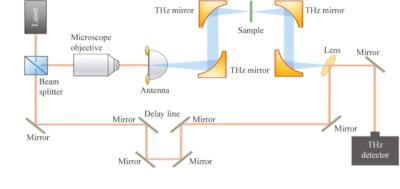Researchers from Shenzhen University recently addressed the stability issue of organic–inorganic hybrid perovskites, which the team says is currently a barrier to their widespread commercial application in optoelectronic devices. In addition to enhancing perovskite stability, the real-time detection of aging status, aimed at monitoring the aging progression, holds paramount importance for both fundamental research and the commercialization of organic–inorganic hybrid perovskites.
Schematic diagram of the THz-TDS system. Image from: Frontiers of Optoelectronics
In their recent work, the team examined the aging status of perovskite in real-time by using terahertz time-domain spectroscopy. This technique is based on the resonant absorption of terahertz waves by phonons in the perovskite. As perovskites age, the intensity of phonon vibration modes associated with the Pb-I bonds decreases, leading to changes in the absorption peaks of terahertz waves at specific frequencies. Based on this, they proposed using the intensity of these terahertz absorption peaks as an indicator to measure the ageing degree of perovskites in real-time.
Their analysis consistently revealed a gradual decline in the intensity of the absorption peak at 0.968 THz with increasing perovskite aging. Furthermore, a systematic discussion was conducted on the variations in intensity and position of the terahertz absorption peaks as the perovskite aged.
The team's findings could offer a practical way to track the ageing of perovskites in real-time. This advancement could help bring perovskite-based devices to the market more quickly, making them more reliable and efficient for everyday use.


